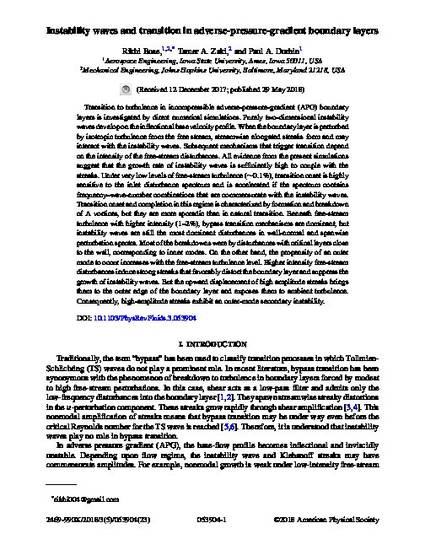
Transition to turbulence in incompressible adverse-pressure-gradient (APG) boundary layers is investigated by direct numerical simulations. Purely two-dimensional instability waves develop on the inflectional base velocity profile. When the boundary layer is perturbed by isotropic turbulence from the free stream, streamwise elongated streaks form and may interact with the instability waves. Subsequent mechanisms that trigger transition depend on the intensity of the free-stream disturbances. All evidence from the present simulations suggest that the growth rate of instability waves is sufficiently high to couple with the streaks. Under very low levels of free-stream turbulence (∼0.1%), transition onset is highly sensitive to the inlet disturbance spectrum and is accelerated if the spectrum contains frequency–wave-number combinations that are commensurate with the instability waves. Transition onset and completion in this regime is characterized by formation and breakdown of Λ vortices, but they are more sporadic than in natural transition. Beneath free-stream turbulence with higher intensity (1–2%), bypass transition mechanisms are dominant, but instability waves are still the most dominant disturbances in wall-normal and spanwise perturbation spectra. Most of the breakdowns were by disturbances with critical layers close to the wall, corresponding to inner modes. On the other hand, the propensity of an outer mode to occur increases with the free-stream turbulence level. Higher intensity free-stream disturbances induce strong streaks that favorably distort the boundary layer and suppress the growth of instability waves. But the upward displacement of high amplitude streaks brings them to the outer edge of the boundary layer and exposes them to ambient turbulence. Consequently, high-amplitude streaks exhibit an outer-mode secondary instability.
Available at: http://works.bepress.com/paul_durbin/20/

This article is published as Bose, Rikhi, Tamer A. Zaki, and Paul A. Durbin. "Instability waves and transition in adverse-pressure-gradient boundary layers." Physical Review Fluids 3, no. 5 (2018): 053904. DOI: 10.1103/PhysRevFluids.3.053904. Posted with permission.